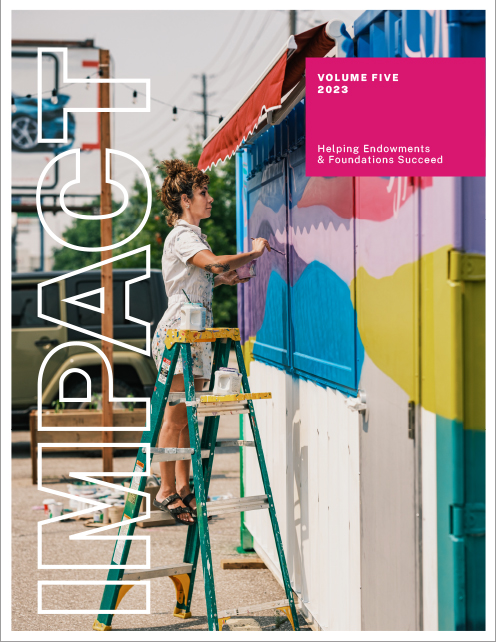Planned giving conversations are often brought up after a major life event: marriage, divorce, retirement, death in the family, etc. In some ways, the COVID-19 pandemic has been a major life event for everybody. It’s brought about significant changes in our day-to-day lives, and it’s led us all to think about what’s important and what we value and for many, that’s meant more seriously contemplating your own mortality for the first time. Before the pandemic, many people put off estate planning. Today, many might be more receptive to the idea.
Yet, the pandemic also gave organizations a fresh set of challenges. The job market, the economy, and politics all affected even the most loyal donors, and when people are uncertain about their future, their giving tends to slow. Alluding to death by mentioning a planned gift carries risk as well. If done too forcefully, egging on donors to include your organization in their will could be considered offensive.

Have you downloaded your copy of Impact?
Get new ideas, fresh inspiration, and more articles like this in our most recent edition of Impact, a publication for non‑profits.
Download nowAll of this leaves your planned giving program in a tricky situation. There is an opportunity today to show how your organization is making a difference and how donors can be a part of that. But there’s also the risk of piling on to a donor’s stress by asking them to consider a big life decision. How do we thread the needle and talk about planned giving in the COVID era? Consider the following ideas for how to communicate effectively with your most loyal donors.
Share stories of legacy and impact
This has a double benefit: sharing the story of a living legacy donor is a great way to thank existing donors and inspire others to make a similar gift. Find a donor willing to share the who, what, and why of their legacy gift and leverage it on your website, newsletters, emails, and in-person meetings. Use this donor as an example and show off the impact of their gift. How does your organization use legacy gifts to fulfill its mission? Maybe there’s a specific service you provide that wouldn’t be possible today without planned gifts. Share these stories in a gentle way to help get the conversation started.
Listen first and follow the donor’s lead
Donors can tell when they’re being led down a road they don’t want to go, and it’s an immediate turn off. The solution is to let the donor take the lead. Your careful marketing up to this point has let them know that there are planned gift options that would help your organization. But if they don’t bring it up, then it’s not the right time. There are obvious key words that you’ll want to listen for: estate plan, will, and legacy. But they might also drop hints more indirectly.
Listen for phrases like
- I wish I could do more
- If your organization had been around when I was younger…
- I wish more people had access to…
- How could I repay your organization?
- I’d like to see a future without…
Concentrate on stewardship
If now is not the right time to ask, then concentrate on stewardship. Over the past year, many organizations have perfected the art of the check-in. Ask donors about their lives. Commiserate about 2020 and shared hardships. Let them know how your organization is doing and the difference you’re making. How have you adapted to better serve your community? And be sure to thank them. If you have information on their history of giving, let them know that you appreciate all they’ve done for your organization and remind them of your long relationship. Even if you’re not asking, it’s important to keep your organization top of mind for potential future donations. Engagement and stewardship are key.
Remember that planned gifts are deferred gifts
One of the biggest selling points of planned giving is that the donor has no immediate outlay. This is a great way to incorporate any near-term concerns donors may have with their personal financial situation or their situation with loved ones. For example, donors with children or a spouse may set up charitable remainder trusts to support their beneficiaries while also positioning the charity to receive the remaining assets once all beneficiaries have passed.
Uncertainty about near-term finances can lead to different priorities for donors, and that’s ok. But it doesn’t mean they need to abandon the possibility of supporting your organization. Many types of gifts, from bequests to charitable trusts, make it possible for donors to take care of loved ones and still leave a charitable legacy. That’s a message that is resonating today.
Stay up-to-date
The world continues to change rapidly, and tax policy changes are impacting donors looking to update or create an estate plan. It remains to be seen what exactly the Biden administration has in mind, but it’s possible we could see significant changes to income, capital gains, and estate taxes over the next few years. Donors appreciate well-thought-out and helpful advice on these topics, making staying up-to-date well worth the effort. It provides an opportunity to engage with donors, cultivate trust over time, and aid in what is often a complicated decision.
Additional resources on Planned Giving
Watch our recent webinar, Leveraging Planned Giving in an Uncertain World, where Juan Bendeck of Hahn Loeser & Parks, LLP and Jack Simpson of Ballad Health Foundation share their experiences in implementing a strong planned giving program.
Use our Planned Giving checklist, which outlines some key actionable items that can help propel your organization’s planned giving program forward.



